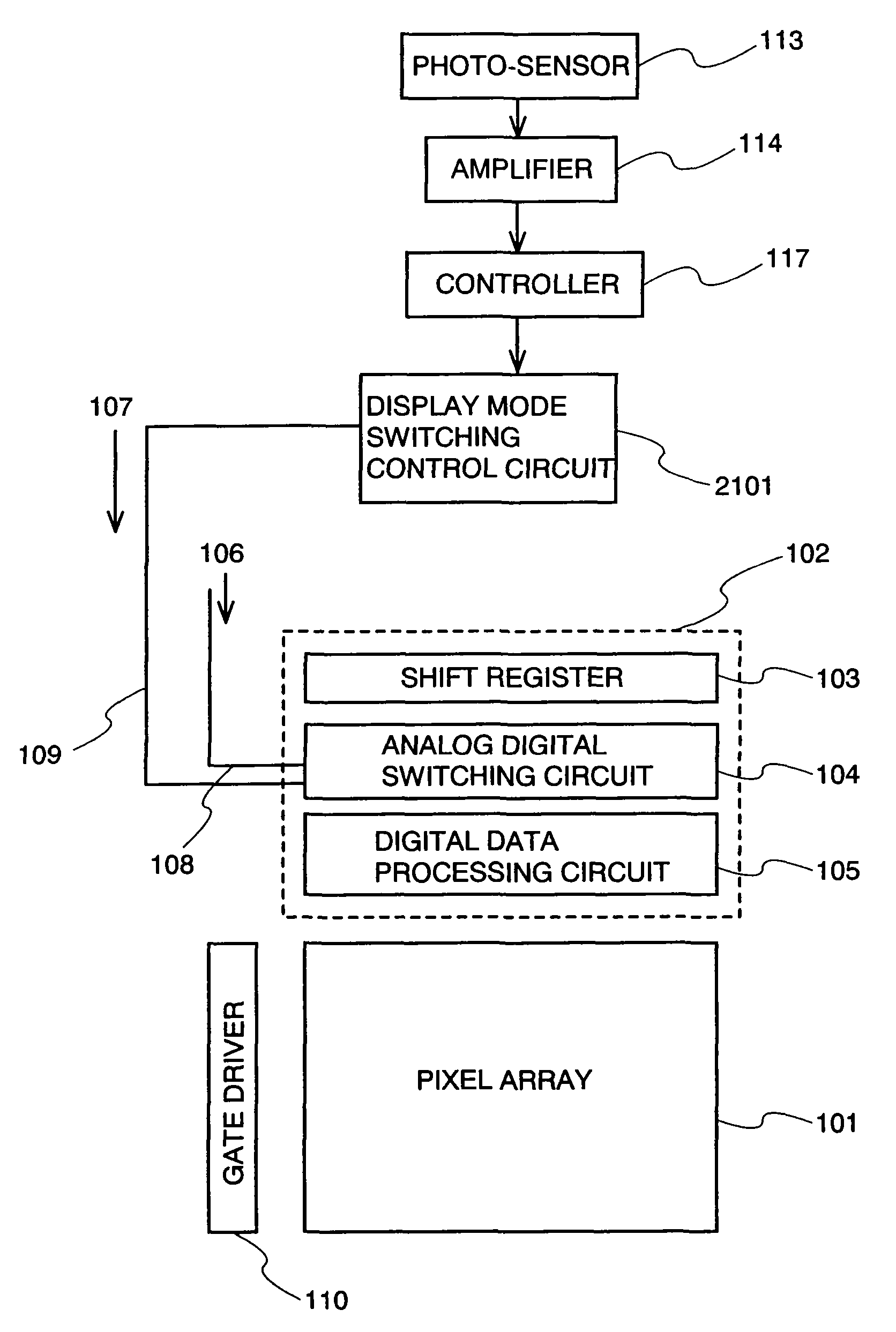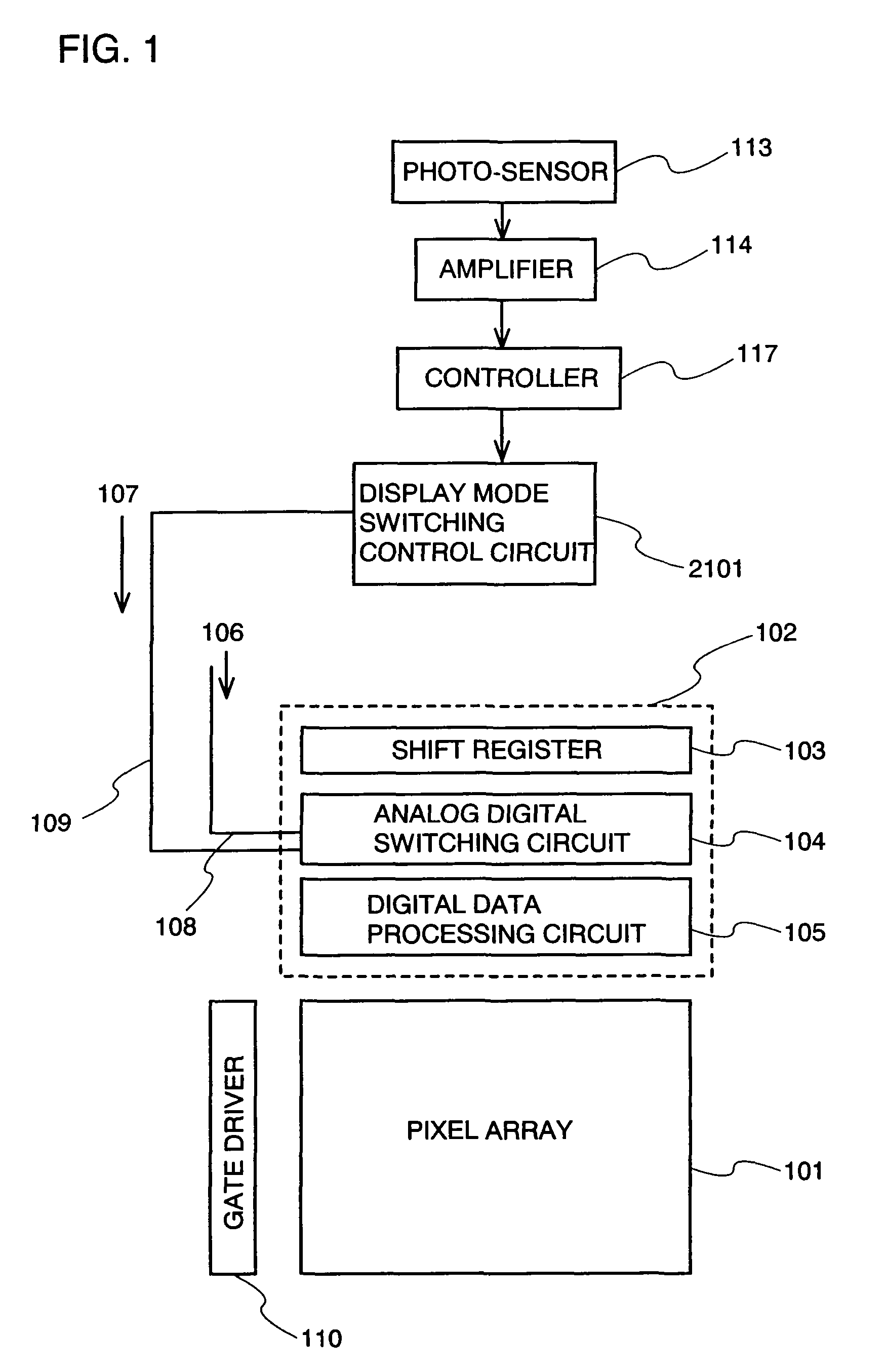Display device and electronic device
a technology of electronic devices and display devices, applied in static indicating devices, electroluminescent light sources, instruments, etc., can solve problems such as unresolved fundamental problems, deterioration of image quality, and significant deterioration of visibility, and achieve the effect of superior visibility
- Summary
- Abstract
- Description
- Claims
- Application Information
AI Technical Summary
Benefits of technology
Problems solved by technology
Method used
Image
Examples
embodiment mode 1
[0081]FIG. 1 shows an overall configuration diagram. A source driver 102 and a gate driver 110 are disposed to drive a pixel array 101. Note that a plurality of the source drivers 102 and gate drivers 110 may each be disposed.
[0082]A photo-sensor 113 detects external light (external light that a display device receives). The output is supplied to an amplifier 114. The amplifier 114 amplifies an electrical signal outputted by the photo-sensor 113, and the amplified electrical signal is supplied to a controller 117. Note that the device can be constituted without the amplifier 114 when the electrical signal outputted by the photo-sensor 113 is sufficiently large.
[0083]The controller 117 controls a display mode switching control circuit 2101. A display mode, the gray scale number, or the like is determined in the display mode switching control circuit 2101. Then, a display mode control signal 107 is controlled by being outputted to the source driver 102.
[0084]The controller 117 control...
embodiment mode 2
[0131]In this embodiment mode, a method for driving a pixel in an analog mode will be described.
[0132]FIGS. 6A and 6B show the relationship between a voltage and a current applied to a driving transistor and a light-emitting element. FIG. 6A shows a circuit of a driving transistor 601 and a light-emitting element 602. The driving transistor 601 and the light-emitting element 602 are connected serially between a wiring 603 and a wiring 604. Since the wiring 603 has a higher potential than that of the wiring 604, a current flows to the light-emitting element 602 from the driving transistor 601.
[0133]The driving transistor 406 in FIG. 4 corresponds to the driving transistor 601 in FIG. 6A, and the light-emitting element 407 in FIG. 4 corresponds to the light-emitting element 602 in FIG. 6A.
[0134]FIG. 6B shows the relationship between a gate-source voltage (or the absolute value thereof) of the driving transistor 60 and a current flowing to the driving transistor 60 and the light-emitti...
embodiment mode 3
[0143]In this embodiment mode, a method for driving a pixel in a digital mode will be described.
[0144]The relationship between the gate-source voltage (or the absolute value thereof) of the driving transistor 601 and a current flowing to the driving transistor 601 and the light-emitting element 602, shown in FIG. 6B, is referred to. In a digital mode, control is performed in binary like on and off, or H and L. In other words, whether or not a current flows to the light-emitting element 602 is controlled. First, a case where current does not flow is considered. In this case, the gate-source voltage (or the absolute value thereof) of the driving transistor 601 may be 0 V or more as indicated by a voltage 624, a voltage 625, and a voltage 626 and equal to or lower than the threshold voltage of the driving transistor 601.
[0145]Next, a case where current flows is considered. In this case, the driving transistor 601 may be operated in a saturation region, a linear region, or a region wher...
PUM
 Login to View More
Login to View More Abstract
Description
Claims
Application Information
 Login to View More
Login to View More - R&D
- Intellectual Property
- Life Sciences
- Materials
- Tech Scout
- Unparalleled Data Quality
- Higher Quality Content
- 60% Fewer Hallucinations
Browse by: Latest US Patents, China's latest patents, Technical Efficacy Thesaurus, Application Domain, Technology Topic, Popular Technical Reports.
© 2025 PatSnap. All rights reserved.Legal|Privacy policy|Modern Slavery Act Transparency Statement|Sitemap|About US| Contact US: help@patsnap.com



